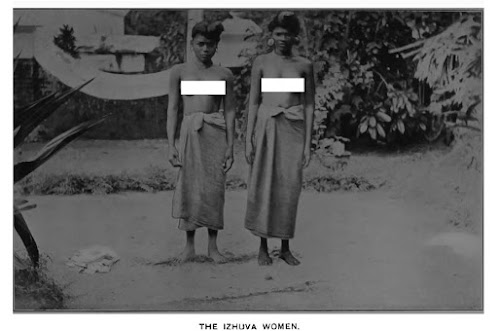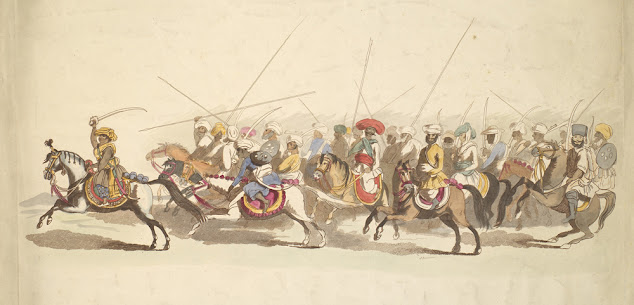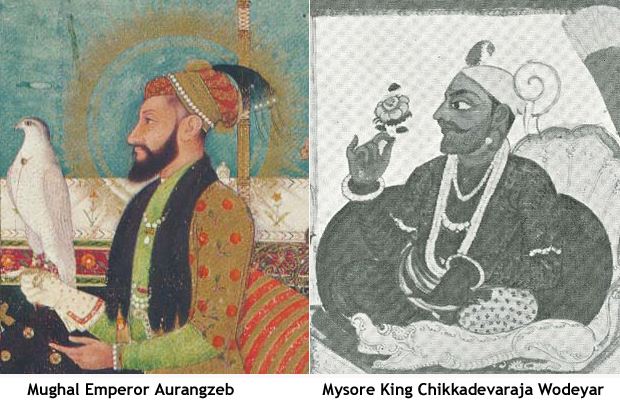Tipu Sultan's victims, or perpetrators of worst human slavery? Nayars of Kerala in 18 and 19 centuries CE
Research and author: Ameen Ahmed
Critics of Tipu Sultan (and Haidar Ali) give examples of four major communities as proof of brutalities and religious bigotry of these father-son rulers- Christians of Coastal Karnataka, Nayars of Malabar (Kerala), Coorgis and Brahmins, particularly the Mandyam Iyengars of Melukote. The later three are often clubbed together as Hindus. And then there is a counter against these arguments by authors who believe Haidar-Tipu were just like other rulers of that day and age- neither heroes nor villains but a product of their times. A closer look at the social structure and caste hierarchy of Kerala in the 18th and 19th centuries and the place of one of the castes- the Nairs during the period, suggests the conflicts may not have been religious.
It is well known fact that Haidar Ali rose to power from the position as an ordinary soldier in the army of the Mysore Hindu Wodeyars in early 1750s. But what is not known much is that when he joined service of Wodeyars, the Wodeyar family members were already prisoners of Nanjaraj, the Hindu Dalwai (Minister) of the Wodeyars. It is also not well known that Haidar Ali conducted his first ever raid of the Malabar region under service of the Wodeyar Dalwais. This attack is part of what some historians now term as 'Mysore invasions of Malabar'. This is not very different from the attacks of the Hindu Maratha Empire against their fellow Hindu Kingdoms particularly Mysore Kingdom (present day Karnataka) during which many towns were plundered, women abducted and raped and Hindu temples burnt and destroyed. Yet only Haidar Ali and Tipu's attacks on Kerala are given as an example of their religious expansion.
Another fact that is overlooked is the social structure and hierarchy of Kerala both during the times of Haidar-Tipu as well as after their deaths was not a Hindu - Muslim or a Hindu - non-Hindu binary. A good indicator of that is the atrocities against the lowest of the Hindu castes (ati-Shudras) like Izuhuvas by those in the caste hierarchy above them, particularly the Nayars and Brahmins. In fact some of the Hindu lower caste members were not considered Hindus and were classified as 'animistic'.
One of the best sources on this subject is L.K.Anantha Krishna Iyer whose preface in volume 1 of The Cochin Tribes and Castes (1909) reads thus:
'I was entrusted with the Ethnographical Survey of the Cochin State in 1902, and the work in connection with it had to be done without prejudice to my duties in the Ernakulam College, in which I was an assistant till very lately. My proposal to deal first with the purely Malayali Hindu and animistic castes of the State, was accepted by the Government, and the investigation into the customs and manners of the local hill and jungle tribes and the lowest castes, was made thereupon.'
'In July 1907, I was asked by the Diwan to revise these monographs and others then ready for publication in order that they might appear in a single volume with illustrations...
...The volume thus deals with all the Malayali and animistic castes, the members of which pollute the high caste-men at various distances, and cannot approach the outer walls of the temples of the higher castes.'
Here are some documented oppression of the lowest castes by Nayars as listed by Iyer in his book:
The Izhuvans (volume 1, p339-340)
Status:
- 'they were treated with contempt by the members of the higher castes, and were owned in a kind of servitude, mitigated to be sure, when contrasted with the predial slaves.'
- 'if a Chogan or Izhuvan dare to pollute a Nair by approaching nearer than the prescribed distance, he was at liberty to cut him down. They are a people, despised by the higher castes, such as the Brahmans and the Nairs, who, whenever they required money, invariably looked to these classes, whence to obtain it.'
- 'They were not permitted to enter within a native court of justice as they might pollute the judges, who were members of the higher castes. The Nairs were their paid advocates in these courts of justice.'
- 'Their approach within thirty-six feet pollutes Brahmans, Kshatriyas, and high castes Sudras.'
- 'They cannot approach Brahman houses or temples, nor can they pass through Brahman villages in Palghat.'
- 'No member of any higher caste eats with them. They eat at the hands of all castes above them, but strictly abstain from taking the food of Kammalans, Valans, Arayans, and the members of other low castes.'
- 'They live in tharas (villages) of their own and are not allowed to take water from the wells of high caste-men. They have their washerman and barber.'
Dress:
- 'The males and females were not formerly permitted to wear an upper garment above the waist.'
Kadupattans (volume 2, p113)
Social status: As has been already said, they belong to the class of low caste Sudras. They pollute the high caste Nayars by touch, and are allowed to enter only the outer enclosure of temples as far as the hali kallu (Sacrificial stone). However, to-day they are agitating for, and bringing forward, their claims to be treated as high caste Nayars. They eat the food of the Brahmans, Ambalavasis and Nayars, but abstain from taking food from the rest of the low caste Sudras, and are also polluted by the touch of other low caste Sudras.'
Chaliyans (volume 2, p118)
The following account of the Chaliyans is taken from the ‘Travels of Duarte Barbosa:
"There is another set of gentiles still lower, whom they call Chaliyana, who are weavers, and have no other business except to weave cloths of cotton, and some of silk, which are of little value, and are used by the common people. And these also have a sect and form of idolatry apart. Their lineage does not mix with any others; only the Nayars may have mistresses amongst the women of their people so that they do not enter their houses without bathing and changing their clothes whenever they have visited them. Many of these are sons of Nayars, and so they are very fine men in their figures, and they bear arms like the Nayars and go to wars and fight very well. In marriages they have the law of the Nayars, and their sons do not inherit. Their wives have the power of doing what they please with themselves, with the Nayars, or with other weavers, and they cannot mix with any other lineage under pain of death.”
Lower castes' response to Nayar and Brahmin oppression
According to British authors, one way the lower castes fought back against Nayar and Brahmin oppression was to convert to Islam. In his introduction to volume two of Anantha Krishna Iyer's 'Cochin Tribes and Castes' (1912) Alfred C Haddon of Christ’s College, Cambridge, England writes (pXV):
It is well known fact that Haidar Ali rose to power from the position as an ordinary soldier in the army of the Mysore Hindu Wodeyars in early 1750s. But what is not known much is that when he joined service of Wodeyars, the Wodeyar family members were already prisoners of Nanjaraj, the Hindu Dalwai (Minister) of the Wodeyars. It is also not well known that Haidar Ali conducted his first ever raid of the Malabar region under service of the Wodeyar Dalwais. This attack is part of what some historians now term as 'Mysore invasions of Malabar'. This is not very different from the attacks of the Hindu Maratha Empire against their fellow Hindu Kingdoms particularly Mysore Kingdom (present day Karnataka) during which many towns were plundered, women abducted and raped and Hindu temples burnt and destroyed. Yet only Haidar Ali and Tipu's attacks on Kerala are given as an example of their religious expansion.
Another fact that is overlooked is the social structure and hierarchy of Kerala both during the times of Haidar-Tipu as well as after their deaths was not a Hindu - Muslim or a Hindu - non-Hindu binary. A good indicator of that is the atrocities against the lowest of the Hindu castes (ati-Shudras) like Izuhuvas by those in the caste hierarchy above them, particularly the Nayars and Brahmins. In fact some of the Hindu lower caste members were not considered Hindus and were classified as 'animistic'.
One of the best sources on this subject is L.K.Anantha Krishna Iyer whose preface in volume 1 of The Cochin Tribes and Castes (1909) reads thus:
'I was entrusted with the Ethnographical Survey of the Cochin State in 1902, and the work in connection with it had to be done without prejudice to my duties in the Ernakulam College, in which I was an assistant till very lately. My proposal to deal first with the purely Malayali Hindu and animistic castes of the State, was accepted by the Government, and the investigation into the customs and manners of the local hill and jungle tribes and the lowest castes, was made thereupon.'
'In July 1907, I was asked by the Diwan to revise these monographs and others then ready for publication in order that they might appear in a single volume with illustrations...
...The volume thus deals with all the Malayali and animistic castes, the members of which pollute the high caste-men at various distances, and cannot approach the outer walls of the temples of the higher castes.'
Here are some documented oppression of the lowest castes by Nayars as listed by Iyer in his book:
The Izhuvans (volume 1, p339-340)
Status:
- 'they were treated with contempt by the members of the higher castes, and were owned in a kind of servitude, mitigated to be sure, when contrasted with the predial slaves.'
- 'if a Chogan or Izhuvan dare to pollute a Nair by approaching nearer than the prescribed distance, he was at liberty to cut him down. They are a people, despised by the higher castes, such as the Brahmans and the Nairs, who, whenever they required money, invariably looked to these classes, whence to obtain it.'
- 'They were not permitted to enter within a native court of justice as they might pollute the judges, who were members of the higher castes. The Nairs were their paid advocates in these courts of justice.'
- 'Their approach within thirty-six feet pollutes Brahmans, Kshatriyas, and high castes Sudras.'
- 'They cannot approach Brahman houses or temples, nor can they pass through Brahman villages in Palghat.'
- 'No member of any higher caste eats with them. They eat at the hands of all castes above them, but strictly abstain from taking the food of Kammalans, Valans, Arayans, and the members of other low castes.'
- 'They live in tharas (villages) of their own and are not allowed to take water from the wells of high caste-men. They have their washerman and barber.'
Dress:
- 'The males and females were not formerly permitted to wear an upper garment above the waist.'
Social status: As has been already said, they belong to the class of low caste Sudras. They pollute the high caste Nayars by touch, and are allowed to enter only the outer enclosure of temples as far as the hali kallu (Sacrificial stone). However, to-day they are agitating for, and bringing forward, their claims to be treated as high caste Nayars. They eat the food of the Brahmans, Ambalavasis and Nayars, but abstain from taking food from the rest of the low caste Sudras, and are also polluted by the touch of other low caste Sudras.'
Chaliyans (volume 2, p118)
The following account of the Chaliyans is taken from the ‘Travels of Duarte Barbosa:
"There is another set of gentiles still lower, whom they call Chaliyana, who are weavers, and have no other business except to weave cloths of cotton, and some of silk, which are of little value, and are used by the common people. And these also have a sect and form of idolatry apart. Their lineage does not mix with any others; only the Nayars may have mistresses amongst the women of their people so that they do not enter their houses without bathing and changing their clothes whenever they have visited them. Many of these are sons of Nayars, and so they are very fine men in their figures, and they bear arms like the Nayars and go to wars and fight very well. In marriages they have the law of the Nayars, and their sons do not inherit. Their wives have the power of doing what they please with themselves, with the Nayars, or with other weavers, and they cannot mix with any other lineage under pain of death.”
Lower castes' response to Nayar and Brahmin oppression
According to British authors, one way the lower castes fought back against Nayar and Brahmin oppression was to convert to Islam. In his introduction to volume two of Anantha Krishna Iyer's 'Cochin Tribes and Castes' (1912) Alfred C Haddon of Christ’s College, Cambridge, England writes (pXV):
'Another interesting community is that of the Mappillas who are described in the Census Report of 1871 as hybrid Muhammadans whose numbers are constantly increased by the conversion of the slave castes of Malabar, which conversion Mr. Logan says “has had a marked effect in freeing the slave caste in Malabar from their former burthens.'
And did the lower castes benefit by such conversions to Islam? Haddon continues his quoting of Logan "By conversion a Cheruman obtains a distinct rise in the social scale, and, if he is in consequence bullied or beaten, the whole Muhammedan community comes to his aid.'
Bowring in his book 'Haidar Ali and Tipu Sultan and the struggle with the Musalman powers of the South' (1893) writes this: '... the western coast, where in former times women of the lower castes were forbidden to cover the upper part of the body in the presence of their superiors. It is related that the Queen of Attangadi ordered the breasts of a woman who had offended against this usage to be cut off.' Bowring adds Tipu passed an edict stopping this practise.
But a look at other sources regarding this and also the practise of polyandry reveals that these practices that seem a social evil today were widely practised and enforced in Kerala then, particularly by Nairs. Any attempt to disrupt the same by any one must have come with huge consequences, as Mysorean armies particularly the ones under Tipu may have realised during their rule there. To this day Tipu Sultan is paying the price of disturbing the status quo of Kerala's caste hierarchy and for liberating Dalit women from its oppressive clutches.
---
But a look at other sources regarding this and also the practise of polyandry reveals that these practices that seem a social evil today were widely practised and enforced in Kerala then, particularly by Nairs. Any attempt to disrupt the same by any one must have come with huge consequences, as Mysorean armies particularly the ones under Tipu may have realised during their rule there. To this day Tipu Sultan is paying the price of disturbing the status quo of Kerala's caste hierarchy and for liberating Dalit women from its oppressive clutches.
---
Further reading:
1) Iyer, L.K.Anantha Krishna The Cochin Tribes and Castes with illustrations, Higginbotham & Co, London, 1909 (in 4 volumes) (downloaded Oct. 29, 2018 URL).2) Menon, Padmanabha K.P A History of Kerala written in the form of notes on Visscher's letters from Malabar, 1924 (in 4 volumes) (downloaded Oct. 29, 2018 URL).3) Dr. C.K.Abdul Kareem, Kerala under Haidar Ali and Tipu Sultan, Paico Publishing House, 1973.4) Sayeed, Vikhar Ahmed Tipu in Malabar, Frontline, Jan. 05, 2018 (downloaded Oct. 29, 2018, URL).
~ ~ ~
ಈ ಬ್ಲಾಗನ್ನು ಕನ್ನಡಲ್ಲಿ ಓದುವುದಕ್ಕಾಗಿ ಇಲ್ಲಿ ಕ್ಲಿಕ್ ಮಾಡಿ
इस ब्लॉग को हिंदी में पड़ने के लिए यहाँ क्लिक करें
~ ~ ~
इस ब्लॉग को हिंदी में पड़ने के लिए यहाँ क्लिक करें
~ ~ ~
You may also like to read






Comments
Post a Comment
Thank you for visiting this blog and sharing your thoughts.